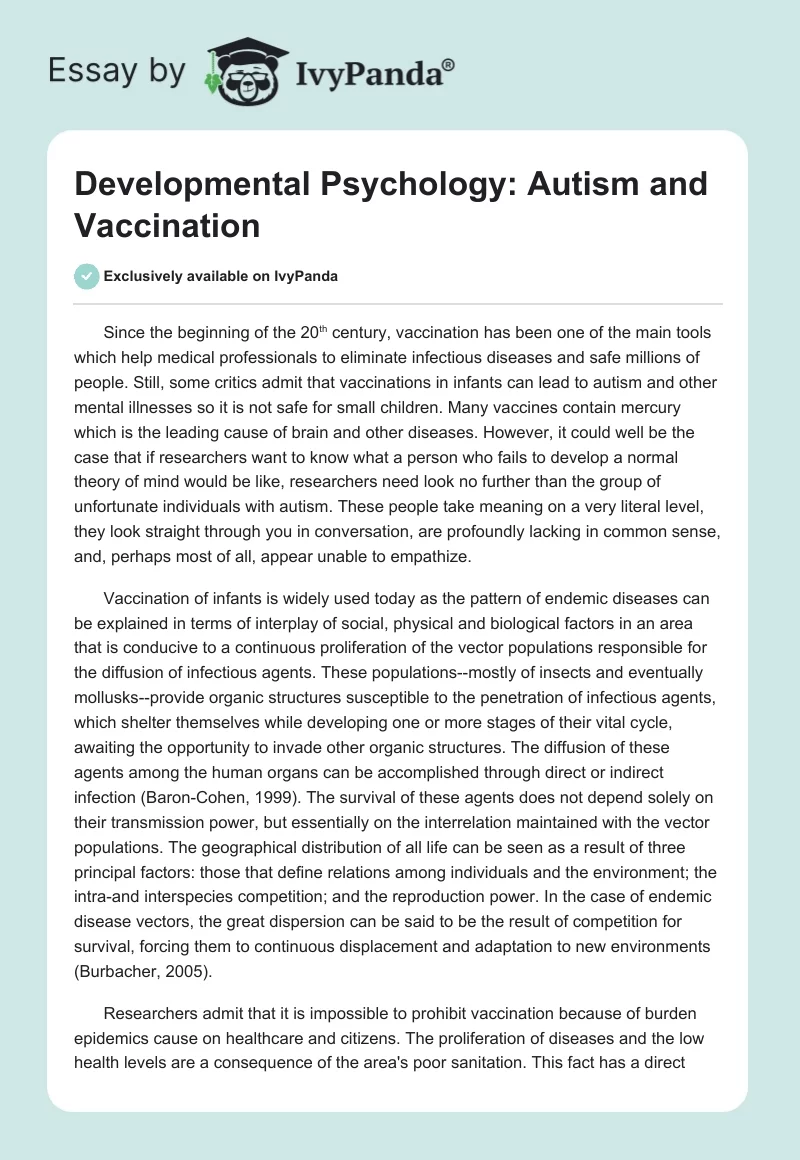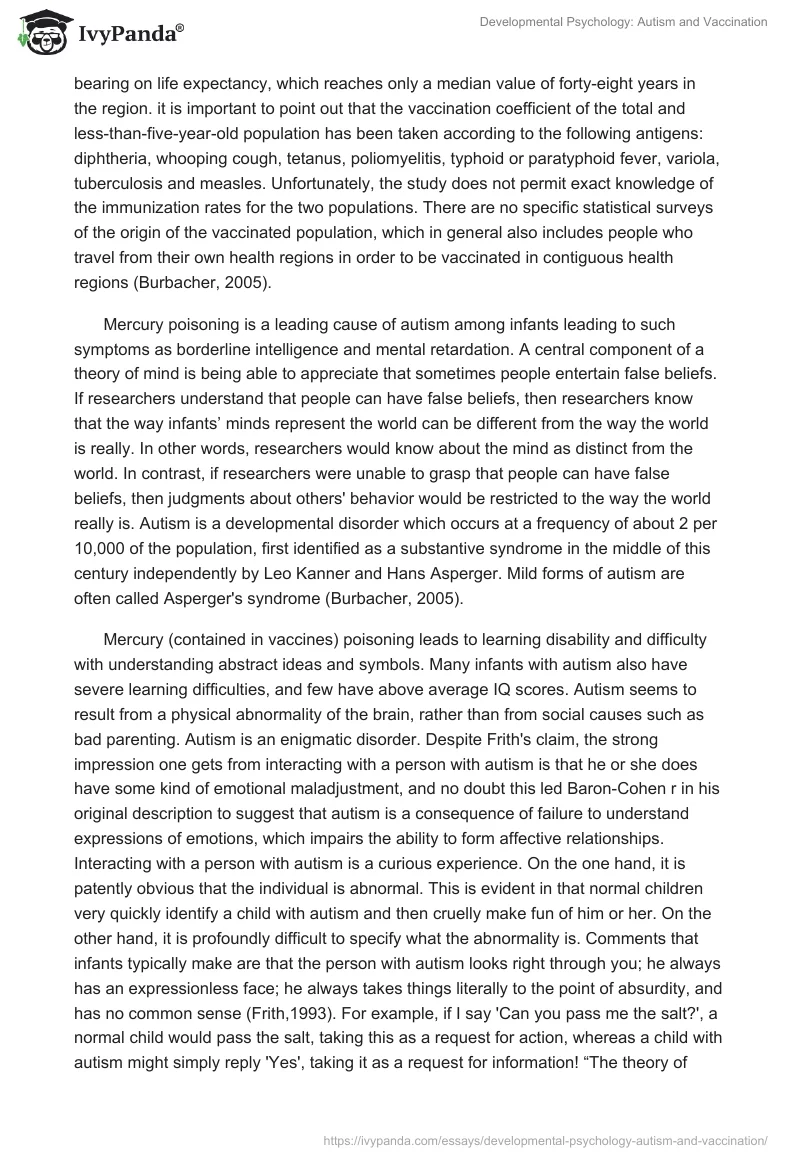Since the beginning of the 20th century, vaccination has been one of the main tools which help medical professionals to eliminate infectious diseases and safe millions of people. Still, some critics admit that vaccinations in infants can lead to autism and other mental illnesses so it is not safe for small children. Many vaccines contain mercury which is the leading cause of brain and other diseases. However, it could well be the case that if researchers want to know what a person who fails to develop a normal theory of mind would be like, researchers need look no further than the group of unfortunate individuals with autism. These people take meaning on a very literal level, they look straight through you in conversation, are profoundly lacking in common sense, and, perhaps most of all, appear unable to empathize.
Vaccination of infants is widely used today as the pattern of endemic diseases can be explained in terms of interplay of social, physical and biological factors in an area that is conducive to a continuous proliferation of the vector populations responsible for the diffusion of infectious agents. These populations–mostly of insects and eventually mollusks–provide organic structures susceptible to the penetration of infectious agents, which shelter themselves while developing one or more stages of their vital cycle, awaiting the opportunity to invade other organic structures. The diffusion of these agents among the human organs can be accomplished through direct or indirect infection (Baron-Cohen, 1999). The survival of these agents does not depend solely on their transmission power, but essentially on the interrelation maintained with the vector populations. The geographical distribution of all life can be seen as a result of three principal factors: those that define relations among individuals and the environment; the intra-and interspecies competition; and the reproduction power. In the case of endemic disease vectors, the great dispersion can be said to be the result of competition for survival, forcing them to continuous displacement and adaptation to new environments (Burbacher, 2005).
Researchers admit that it is impossible to prohibit vaccination because of burden epidemics cause on healthcare and citizens. The proliferation of diseases and the low health levels are a consequence of the area’s poor sanitation. This fact has a direct bearing on life expectancy, which reaches only a median value of forty-eight years in the region. it is important to point out that the vaccination coefficient of the total and less-than-five-year-old population has been taken according to the following antigens: diphtheria, whooping cough, tetanus, poliomyelitis, typhoid or paratyphoid fever, variola, tuberculosis and measles. Unfortunately, the study does not permit exact knowledge of the immunization rates for the two populations. There are no specific statistical surveys of the origin of the vaccinated population, which in general also includes people who travel from their own health regions in order to be vaccinated in contiguous health regions (Burbacher, 2005).
Mercury poisoning is a leading cause of autism among infants leading to such symptoms as borderline intelligence and mental retardation. A central component of a theory of mind is being able to appreciate that sometimes people entertain false beliefs. If researchers understand that people can have false beliefs, then researchers know that the way infants’ minds represent the world can be different from the way the world is really. In other words, researchers would know about the mind as distinct from the world. In contrast, if researchers were unable to grasp that people can have false beliefs, then judgments about others’ behavior would be restricted to the way the world really is. Autism is a developmental disorder which occurs at a frequency of about 2 per 10,000 of the population, first identified as a substantive syndrome in the middle of this century independently by Leo Kanner and Hans Asperger. Mild forms of autism are often called Asperger’s syndrome (Burbacher, 2005).
Mercury (contained in vaccines) poisoning leads to learning disability and difficulty with understanding abstract ideas and symbols. Many infants with autism also have severe learning difficulties, and few have above average IQ scores. Autism seems to result from a physical abnormality of the brain, rather than from social causes such as bad parenting. Autism is an enigmatic disorder. Despite Frith’s claim, the strong impression one gets from interacting with a person with autism is that he or she does have some kind of emotional maladjustment, and no doubt this led Baron-Cohen r in his original description to suggest that autism is a consequence of failure to understand expressions of emotions, which impairs the ability to form affective relationships. Interacting with a person with autism is a curious experience. On the one hand, it is patently obvious that the individual is abnormal. This is evident in that normal children very quickly identify a child with autism and then cruelly make fun of him or her. On the other hand, it is profoundly difficult to specify what the abnormality is. Comments that infants typically make are that the person with autism looks right through you; he always has an expressionless face; he always takes things literally to the point of absurdity, and has no common sense (Frith,1993). For example, if I say ‘Can you pass me the salt?’, a normal child would pass the salt, taking this as a request for action, whereas a child with autism might simply reply ‘Yes’, taking it as a request for information! “The theory of mind suggests that the key social, communicative and imaginative impairments which characterize this disorder result from an inability to represent mental states” (Frith et al 1994, p. 108).
Mercury poisoning leads to changes in infants’ behavior and motor skills, and as a result to autism. After vaccination, more able infants with autism often display special abilities. Some are advanced at reading, drawing, memorizing bus timetables, and so on. However, many of these special abilities turn out to be useless in practice. For example, some people with autism can rapidly work out the day of the week a particular date will fall on at almost any point in time. This is a remarkable cognitive feat, but it is difficult to envisage how it could be utilized in any practical way. In contrast to the few pockets of exceptional cognitive functioning bright people with autism enjoy, when it comes to comprehending text, or understanding the implications of things, they perform very poorly. people with autism do not suffer from an emotional disorder, but from a cognitive one. She suggests that it is the nature of normal people to try to impose sense and meaning on things, to look for patterns in experiences, and interpret them (Frith and Happe, 1994). This can be seen in the case of the ‘gambler’s fallacy’. If researchers toss an unbiased coin, 50 per cent of the time it will be heads. In other words, the probability of heads on each toss is.5. There is no pattern to be found in the sequence of heads and tails, it is purely chance. Though, the gambler’s fallacy is that there is a pattern. So if the last five tosses have yielded heads, the gambler may fallaciously believe that the probability of the next toss resulting in tails is increased. This is not so, and the probability of tails remains.5. This goes to show that researchers, as gamblers and in other aspects of life, have a strong tendency to look for sense, meaning and patterns in the world. Frith’s view is that people with autism, in sharp contrast, have no such tendency. The point Frith makes is that autism is not primarily an emotional disorder, but rather is a cognitive deficit in the form of a failure to try to make sense of things. The high frequency of error could not simply have been due to mental immaturity of the children with autism (Steuernagel, 2005). Prior to doing the test, the children with autism had their mental age assessed, to ensure that it was well above 4 years, the age at which most normal children succeed on the task. “The conclusion that children with autism are indeed impaired in this domain only becomes possible because of the convergence of results from widely differing experimental paradigms” (Baron-Cohen 1999, p. 5).
The other problem is that vaccination (and mercury poisoning) can influence genetics of a child and heredity. This intriguing finding suggests that although in some respects the mind theorizing of children with autism resembles that of a normal 3-year-old, in other respects it could be quite different. In particular, children with autism may not have a general difficulty with misrepresentation, unlike normal 3-year-olds, as revealed by their success in performing on the misrepresentation photo task. Instead, it seems that their difficulty could be restricted to acknowledging that the mind is distinct from the external world, with failure to recognize false belief serving as a symptom of this (Steuernagel, 2005). The possibility that a central feature of autism is the possession of an inadequate theory of mind is very new, and as yet there has been little opportunity for the possibility to be assessed critically. Consequently, researchers proceed with some caution. These symptoms are all consistent with the person with autism having no notion of other people’s meanings, intentions and feelings. In this decade researchers could see the emergence of a finer understanding of autism, as researchers take on board the important and revolutionary ideas (Steuernagel, 2005).
Down’s syndrome a disorder due to genetic aberration which gives rise to abnormal brain development and psychological handicap as a consequence, but which is quite unlike autism in terms of the behavior exhibited by the individual. The Smarties test posed no difficulty for the children with Down’s syndrome, and they correctly judged that another person would wrongly think the tube contained Smarties. The good performance of these children was all the more interesting given that they had a lower mental age on average, compared with the children with autism. This finding suggests that failure on the Smarties test does not result from a general difficulty in developmentally handicapped children, but rather might be specific to a deficit children with autism have (Steuernagel, 2005). According to Frith, the deficit in question is that people with autism are unable to acknowledge false belief and therefore are lacking in a fundamental basis required for the development of a theory of mind. To put it more strongly, perhaps the symptoms of autism are the symptoms of having no theory of mind. Steuernagel admits that “Blaming autism on vaccinations has much to recommend it. Parents who have their children vaccinated are doing something “good” for their children in protecting them against disease” (138).
Saturated with mercury, the immune system cannot function properly and protect an infant from unstable influences from the environment. So, mortality indicators have been the most frequently utilized, as death constitutes an actual event, internationally defined and subjected to a direct measurement. Vaccination leads to autism and autism-related disorders because of mercury poisoning and intoxications caused by vaccines. The indicator has some limitations largely due to the under-enumeration of death as a result of faulty surveys and the lack of “causa mortis” registration. Still, researchers admit that the general and specific mortality indicators, which are more sensitive to such deficiencies, have been replaced by the proportional mortality values according to age and types and causes.
References
Baron-Cohen, B. (1999). The Extreme-Male-Brain Theory of Autism. This paper appeared in In Tager-Flusberg, H, (ed) Neurodevelopmental Disorders. MIT Press.
Burbacher, Th. M. (2005). Comparison of Blood and Brain Mercury Levels in Infant Monkeys Exposed to Methylmercury or Vaccines Containing Thimerosal. Environmental Health Perspectives, 113 (1), 1013.
Frith, U. (1993). Autism. Scientific American. June, pp. 108-114.
Frith, U., Happe, F. (1994). Autism: Beyond Theory of Mind. Cognition, 50, pp. 115-132.
Frith, U., Happe, F., Siddons, F. (1994). Autism and Theory of Mind in Everyday Life. Oxford UK.
Steuernagel, T. (2005). Increases in Identified Cases of Autism Spectrum Disorders: Policy Implications. Journal of Disability Policy Studies, 16 (1), 138.


